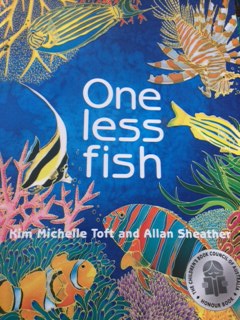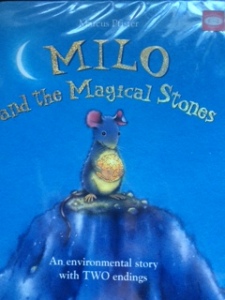One less fish is a colourful, informative and pertinent story about the Great Barrier Reef and the amazing sea creatures within.

I’m sure many of you are aware of the coral bleaching that has been occurring in the GBR over the past year. The coral reef is such an important part of our natural world and more importance needs to be placed upon this destruction.
I have been lucky enough to visit the reef, see the vibrant coral and swim amongst the different sea creatures that live there. Many people will miss out on this opportunity if we don’t start to take action.
The picture book One Less Fish by Kim Michelle Toft and Allan Sheather allows children to see the fish that swim amongst the coral. The beautiful illustrations show the diversity that swims in the Great Barrier Reef and highlights the beauty of the coral that the fish live between.
One Less Fish was written to show readers what may have happened if it had not been inscribed on the World Heritage List in 1981. Each page gives tips on how we can start to make changes so that less destruction takes place towards to Reef, the ocean and the sea creatures.
Although this book seems sad and without hope as fish diminish one by one it ends on a high with all of the fish returning.
One Less Fish is a great teaching resource through the tips on each page and the glossary on the last two pages. It also allows children to see what sorts of fish live in the Great Barrier Reef and allows them to hear what can happen through small less thoughtful actions. It also is a great starting point to discuss with them what we can do today, to ensure there is less harm done.
TEACHING TIPS
When I read this story to my children they loved counting the fish, talking about the different colours in each image and finding out the names of the creatures.
So what can you do?
SCIENCE
- Allow time to research a fish or another sea creature that lives in the Great Barrier Reef. Find out as much as possible about that creature. Ask the question – how will they be effected by coral bleaching?
- Find up to date information about the Great Barrier Reef: How it is used, who uses it and the governments approach to it.
- Create a Venn diagram that compares two animals of the Great Barrier Reef.
- Find out the life cycles of the different types of GBR fish. You will be amazed at how different they are!
- Forming small groups look at the different tips that are offered on each page – research these issues to gain more understanding of them. Are they still issues? Are there more issues since this book was written in 1997?
- Watch this Ted talk to see how scientists are working on saving the reef. https://www.ted.com/talks/kristen_marhaver_how_we_re_growing_baby_corals_to_rebuild_reefs?language=en
MATHEMATICS
- Count the fish as you go. Show addition and take away sums as you read through the story.
- How many fish are there in the whole story?
- How many years has the reef been listed on the World Heritage List?
- Look at temperature charts of the sea water over the last ten years. Discuss how this effects the coral.
- Older children may love to look at the mathematics of coral! https://www.ted.com/talks/margaret_wertheim_crochets_the_coral_reef?language=en
THINKING, TALKING & SHARING
- Do people think differently now than in 1997? Have we continued to protect the reef?
- What can we do if we live far away from the reef?
One less fish won a CBCA award in 1998
MATHEMATICS
STAGE One
Represent and solve simple addition and subtraction problems using a range of strategies including counting on, partitioning and rearranging parts (ACMNA015)
SCIENCE
Stage One
People use science in their daily lives, including when caring for their environment and living things (ACSHE022)
Stage two
Science knowledge helps people to understand the effect of their actions (ACSHE051)
Living things depend on each other and the environment to survive (ACSSU073)
Stage three
The growth and survival of living things are affected by physical conditions of their environment (ACSSU094)


